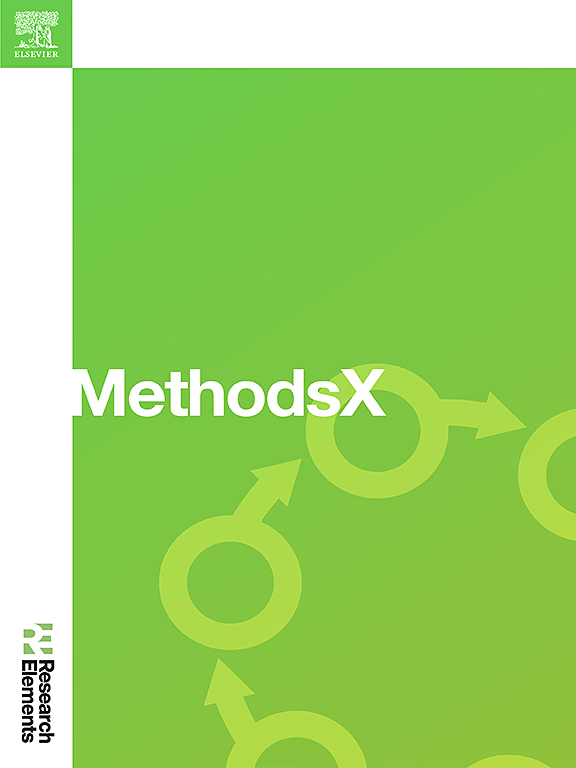烷基酰胺支架上氧化磷脂的简化合成
IF 1.6
Q2 MULTIDISCIPLINARY SCIENCES
引用次数: 0
摘要
氧化磷脂(OxPLs)含有氧化脂肪酸(氧化脂素),在各种疾病中发挥着重要作用。然而,由于结构不同的脂质种类的化学合成非常复杂,研究氧化磷脂的结构-活性关系及其信号机制具有挑战性。在这项研究中,我们旨在开发一种方法,将游离的氧脂素附着到溶血磷脂上形成 OxPLs。我们假设氧脂可以通过已知的羧酸活化酯和氨基之间的化学反应轭合到溶血磷脂上。我们使用 N-羟基琥珀酰亚胺和偶联试剂激活了氧化脂的羧基,然后将其与在 sn-2 位含有 NH2-基团的溶血磷脂酰胆碱共轭,形成酰胺键。所有反应都是在温和的条件下进行的,而且产量很高。为防止酰基迁移,聚乳酸的 sn-1 位用通过醚键连接的烷基残基修饰。我们成功合成、分离并鉴定了几种含氧脂素的聚乳酸。研究发现,这些烷基酰胺 OxPLs 的抗TLR4 活性和内皮屏障保护活性与二酰基 OxPLs 相当。该方法可高效合成用于生物测试的改性 OxPLs。醚键和酰胺键的结合增强了生物稳定性,简化了效应分析。该方法描述了多种胆碱磷脂的单一前体的制备,特别是 2-脱氧-2-氨基-1-赖氨酰-3-甘油磷酸胆碱,然后将氧化脂素附着在其上。本文章由计算机程序翻译,如有差异,请以英文原文为准。

Simplified synthesis of oxidized phospholipids on alkyl-amide scaffold
Oxidized phospholipids (OxPLs), containing oxidized fatty acids (oxylipins), play a significant role in various diseases. However, studying the structure-activity relationships of OxPLs and their signaling mechanisms is challenging due to the complexity of the chemical synthesis of structurally distinct lipid species. In this study, we aimed to develop a method for attaching free oxylipins to a lysophospholipid to form OxPLs. We hypothesized that oxylipins could be conjugated to PLs via a known chemical reaction between activated esters of carboxylic acids and amino groups. The carboxyl groups of oxylipins were activated using N-hydroxysuccinimide and a coupling reagent, then conjugated to a lyso-phosphatidylcholine containing NH2-groupd at sn-2 position, forming amide bonds. All reactions were performed under mild conditions and demonstrated high yields. To prevent acyl migration, the sn-1 position of PLs was modified with an alkyl residue linked via an ether bond. Several oxylipin-containing PLs were successfully synthesized, isolated, and characterized. The anti-TLR4 and endothelial barrier-protective activities of these alkyl-amide OxPLs were found to be equivalent to diacyl-OxPLs. This method enables efficient synthesis of modified OxPLs for biological testing. The combination of ether and amide bonds enhances biological stability and simplifies effect analysis.
- •The method describes the preparation of a single precursor for multiple choline PLs, specifically 2-deoxy-2-amino-1-lyso-sn-3-glycerophosphocholine, followed by the attachment of oxylipins to it.
- •No protection-deprotection steps are needed for oxylipins for the synthesis of phosphatidylcholines.
- •Isolation of compounds is performed using fast liquid-liquid and solid-phase extractions.
求助全文
通过发布文献求助,成功后即可免费获取论文全文。
去求助
来源期刊

MethodsX
Health Professions-Medical Laboratory Technology
CiteScore
3.60
自引率
5.30%
发文量
314
审稿时长
7 weeks
期刊介绍:
 求助内容:
求助内容: 应助结果提醒方式:
应助结果提醒方式:


